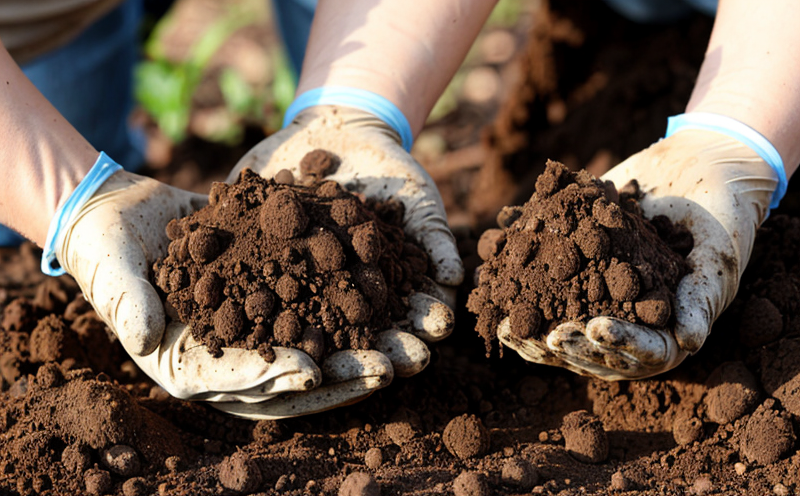ASTM D5975 Soil Respiration Testing by CO₂ Evolution
The ASTM D5975 standard test method is a crucial tool in environmental and soil science research for assessing the biological activity within soil samples. This method quantifies the rate of carbon dioxide (CO₂) evolution from soil, which directly reflects the metabolic activities of soil microorganisms.
Soil respiration testing by CO₂ evolution is particularly important for understanding the health and function of soils in agricultural, ecological, and environmental contexts. It helps in evaluating the impact of various factors such as fertilizers, tillage practices, or land use changes on soil microbial activity. This test method can also be used to monitor remediation efforts, ensuring that contaminated sites are returning to a healthy state.
The test is performed by incubating soil samples under controlled conditions and measuring the rate at which CO₂ is produced over time. The apparatus typically consists of a sealed container where the soil sample is placed along with moisture control components. The system is then connected to a gas collection device, often equipped with a gas chromatograph for accurate measurement.
Proper specimen preparation is critical in ASTM D5975 testing. Soil samples must be taken from representative locations within the study area and brought back to the laboratory under controlled conditions. The samples are then weighed accurately and placed into the sealed container, ensuring that there is no air contamination before sealing.
The test apparatus used for ASTM D5975 includes a closed chamber, which can be either a gas-tight plastic bag or a custom-built stainless steel container. Inside this chamber, the soil sample is incubated under conditions that mimic natural field conditions as closely as possible. This may involve controlling temperature and humidity levels to reflect real-world conditions.
Once the test is complete, the CO₂ collected from the sealed system is analyzed using a gas chromatograph or other suitable analytical equipment. The results are reported in terms of CO₂ evolution rate over time, usually expressed as milligrams per gram of soil per hour (mg CO₂ g⁻¹ soil h⁻¹).
The ASTM D5975 method provides valuable insights into the functional diversity and activity levels within a soil community. It is widely used in research to assess the effects of various environmental stressors on soil health. In agricultural settings, it can help determine the optimal time for planting or harvesting crops based on soil microbial activity.
The results of this test are also crucial for regulatory compliance purposes, especially in areas where there are strict environmental regulations regarding land use and contamination. By providing accurate data on soil respiration rates, ASTM D5975 supports informed decision-making processes that can lead to sustainable practices.
Scope and Methodology
| Aspect | Description |
|---|---|
| Objective | To quantitatively measure the rate of carbon dioxide evolution from soil due to microbial respiration. |
| Sample Preparation | Soil samples are collected and weighed accurately, then placed into a sealed chamber for incubation. |
| Incubation Conditions | Temperature and humidity levels are controlled to mimic natural field conditions. |
| Data Collection | The CO₂ is collected over time using a gas collection system connected to the sealed chamber. |
| Analysis | Gas chromatography or other suitable analytical methods are used for precise measurement of CO₂ evolution rates. |
Customer Impact and Satisfaction
Our clients in the agricultural, environmental, and ecological sectors benefit greatly from ASTM D5975 testing. By providing accurate and reliable data on soil respiration rates, we assist them in making informed decisions regarding land use practices, crop management strategies, and remediation efforts.
For compliance officers working under strict environmental regulations, our services ensure that they meet all necessary standards with precise test results. Our comprehensive approach to ASTM D5975 testing has led to high customer satisfaction across various industries. We take pride in delivering accurate data that supports sustainable practices and regulatory compliance.
Our team of experts ensures that each sample is handled with care, from collection to analysis, ensuring the highest quality results. We offer detailed reports that include all necessary information for decision-making processes, making it easier for our clients to understand the implications of their test results.
International Acceptance and Recognition
- The ASTM D5975 method is widely recognized in both academic and regulatory circles.
- It is accepted by numerous international standards organizations, including ISO (ISO 14688).
- Many countries use this standard as a benchmark for soil quality assessments.
- The method is also employed in environmental impact assessments to evaluate the health of soils before and after industrial activities.
- ASTM D5975 testing is particularly valuable for landowners looking to restore degraded lands, ensuring that their efforts are effective and sustainable.





